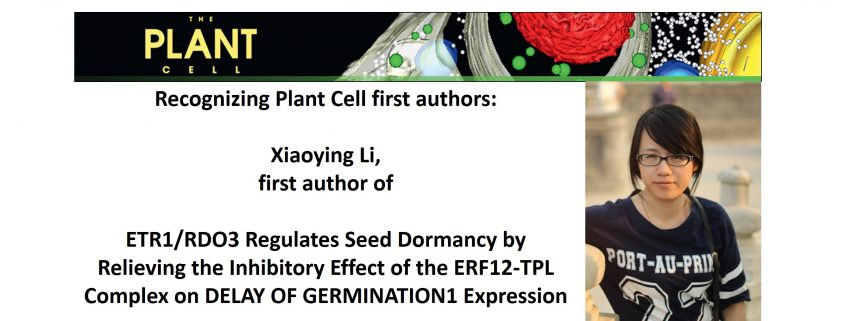Recognizing Plant Cell first author: Xiaoying Li
Xiaoying Li, first author of ETR1/RDO3 Regulates Seed Dormancy by Relieving the Inhibitory Effect of the ERF12-TPL Complex on DELAY OF GERMINATION1 Expression
Current Position: Postdoctoral fellow, Key Laboratory of Plant Molecular Physiology, Institute of Botany, Chinese Academy of Sciences, Beijing, China
Education: PhD in Plant Molecular Physiology (2010-2016), Institute of Botany, Chinese Academy of Sciences, Beijing, China
Non-scientific Interests: Photography, drawing and badminton
Brief bio: During my undergraduate study, I developed a great interest in plant science. My graduation thesis was cytological analysis of Sparganium stoloniferum on systematic classification. During my master study, my work was focused on the identification mechanism of pollen-stigma of distant hybrid sterility in Lilium. In 2010, I got the honor to study for a doctor’s degree in Dr. Yongxiu Liu ‘s group, and carried out the research on the regulation mechanism of seed dormancy. From then, I really come to do the research related to plant molecular genetics which I prefer. I confirmed that the non-dormant mutant rdo3 was caused by a mutation in ethylene receptor ETR1 through the map-based cloning. ERF12, which is an ethylene response factor, was up-regulated in rdo3, and genetic analysis indicated that ERF12 negatively regulated seed dormancy downstream of ETR1. ERF12 could recruit the transcriptional co-repressor TOPLESS to the promoter of DOG1 to inhibit the expression of DOG1, and further regulated seed dormancy. Thus, I identified a dormancy pathway ETR1-ERF12/TPL-DOG1 and provided a mechanistic insight on the regulation of seed dormancy by linking the ethylene and DOG1 pathways, which has important theoretical guiding significance for the optimal breeding in agriculture.
姓名:李小英
教育经历: 2010-2016 中国科学院植物研究所 植物分子生理学 理学博士
兴趣爱好:摄影、绘画和羽毛球
科研经历简介:在本科学习期间,我对植物科学产生了很大兴趣,本科毕业论文是黑三棱在系统分类上的细胞学分析。硕士期间,我的工作主要是百合远缘杂交不育之花粉-柱头识别的机制研究。2010年,我有幸进入刘永秀老师课题组攻读博士学位,在那我才真正接触到我喜欢的植物分子遗传学研究。通过图位克隆技术,我们发现不休眠突变体rdo3是乙烯受体ETR1上的碱基发生了突变。乙烯响应因子ERF12在rdo3中表达上调,并且遗传数据分析显示ERF12在ETR1下游负调控种子的休眠。ERF12招募转录共抑制因子TOPLESS结合到DOG1启动子,抑制DOG1的表达,进而调控种子的休眠。因此,我们归纳出调控种子休眠的ETR1-ERF12/TPL-DOG1途径,将乙烯信号途径与DOG1途径连接起来,为深入了解种子休眠的机制提供了新见解。该研究成果对农业生产实现优产、高产具有一定的理论指导意义。




